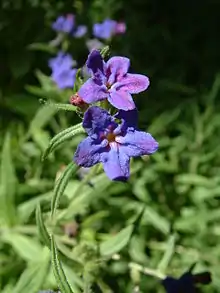Lithospermum
Lithospermum is a genus of plants belonging to the family Boraginaceae. The genus is distributed nearly worldwide, but most are native to the Americas and the center of diversity is in the southwestern United States and Mexico.[1] Species are known generally as gromwells or stoneseeds.
| Lithospermum | |
|---|---|
 | |
| Lithospermum purpurocaeruleum | |
| Scientific classification | |
| Kingdom: | Plantae |
| Clade: | Tracheophytes |
| Clade: | Angiosperms |
| Clade: | Eudicots |
| Clade: | Asterids |
| Order: | Boraginales |
| Family: | Boraginaceae |
| Subfamily: | Boraginoideae |
| Genus: | Lithospermum L. |
| Type species | |
| Lithospermum officinale | |
| Species | |
|
about 50-60, see text | |
Taxonomy
There are about 50[2] to 60[3] species in the genus.
Some species, such as Lithospermum arvense, are sometimes classified in the genus Buglossoides, but that genus is subsumed into Lithospermum by works such as the Flora of China.[2] In addition, a 2009 molecular study showed that the genus Onosmodium should be included within Lithospermum.[1]
- Lithospermum arvense (syn. Buglossoides arvensis) - field gromwell, corn gromwell
- Lithospermum azuayensis[6]
- Lithospermum bejariense - western marbleseed
- Lithospermum bolivariensis[6]
- Lithospermum californicum - California stoneseed
- Lithospermum calycosum - Chinati stoneseed
- Lithospermum canescens - hoary puccoon, Indian-paint
- Lithospermum caroliniense - Carolina gromwell, hairy puccoon
- Lithospermum cobrense - smooththroat stoneseed
- Lithospermum confine - Arizona stoneseed
- Lithospermum cuzcoensis[6]
- Lithospermum erythrorhizon - purple gromwell, red-root gromwell, 紫草 zicao (Pinyin: zǐcǎo), 紫草 murasaki・sō (Japanese)
- Lithospermum hancockianum
- Lithospermum incisum - narrowleaf stoneseed, fringed gromwell
- Lithospermum latifolium - American stoneseed
- Lithospermum leymebambensis[6]
- Lithospermum macbridei
- Lithospermum matamorense - rough stoneseed
- Lithospermum mirabile - San Antonio stoneseed
- Lithospermum molle - softhair marbleseed
- Lithospermum multiflorum - manyflowered stoneseed
- Lithospermum obtusifolium - roundleaf stoneseed
- Lithospermum officinale - common gromwell, European stoneseed
- Lithospermum parksii - Parks' stoneseed
- Lithospermum parviflorum - eastern prairie marbleseed
- Lithospermum purpurocaeruleum (syn. Buglossoides purpurocaerulea) - purple gromwell
- Lithospermum rodriguezii[6]
- Lithospermum ruderale - western stoneseed, Columbia puccoon, wayside gromwell, whiteweed
- Lithospermum tuberosum - southern stoneseed, tuberous gromwell
- Lithospermum viride - green stoneseed
Ecology
Lithospermum leaves are eaten by the caterpillars of certain Lepidoptera, such as the moth Ethmia pusiella which has been recorded on L. officinale.
Uses
The dried root of Lithospermum erythrorhizon is a Chinese herbal medicine with various antiviral and biological activities, including inhibition of human immunodeficiency virus type 1 (HIV-1).[7][8] Lithospermum purpurocaeruleum is native to Japan, where it has been traditionally used to make a purple dye. In southwestern North America, a species of this genus was used as a contraceptive by the Shoshone Native American tribe.[9]
References
- Cohen, James I.; Davis, Jerrold I. (2009). "Nomenclatural changes in Lithospermum (Boraginaceae) and related taxa following a reassessment of phylogenetic relationships". Brittonia. 61 (2): 101–111. doi:10.1007/s12228-009-9082-z.
- "Lithospermum Linnaeus, Sp. Pl. 1: 132. 1753". Flora of China.
- Cohen, J. I., (2012). Comparative floral development in Lithospermum (Boraginaceae) and implications for the evolution and development of heterostyly. American Journal of Botany 99(5), 797-805.
- GRIN Species Records of Lithospermum. Archived 2015-09-24 at the Wayback Machine Germplasm Resources Information Network (GRIN).
- Lithospermum. USDA PLANTS: North American species.
- Weigend, M., et al. (2010). Five new species of Lithospermum L.(Boraginaceae tribe Lithospermeae) in Andean South America: another radiation in the Amotape-Huancabamba zone. Taxon 59(4), 1161-79.
- Chen, X., et al. (2003). Shikonin, a component of Chinese herbal medicine, inhibits chemokine receptor function and suppresses human immunodeficiency virus type 1. Antimicrobial Agents and Chemotherapy 47(9), 2810-16.
- Gao, H., et al. (2011). Anti-adenovirus activities of shikonin, a component of Chinese herbal medicine in vitro. Biol Pharm Bull. 34(2) 197-202.
- "Health - Contraceptive, Indian Style". Chatelaine. June 1964.
External links
- . New International Encyclopedia. 1905.
| Wikimedia Commons has media related to Lithospermum. |